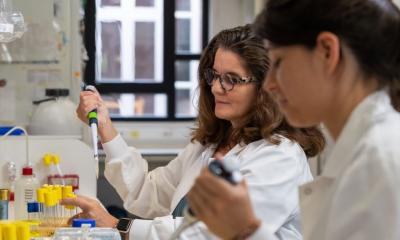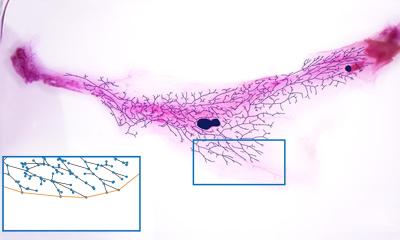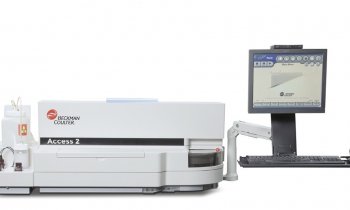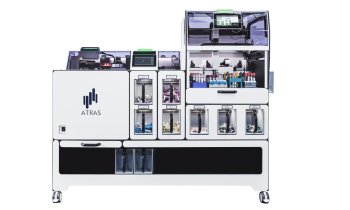Advanced Laboratory For In-Orbit Science
Columbus was onboard NASA's Space Shuttle Atlantis when it lifted off from the Kennedy Space Center in Cape Canaveral, Florida at 20:45 CET 7 Feb 2008. For this one-way trip to Earth orbit, Columbus is in the expert hands of a crew of seven astronauts, including two members of the European astronaut corps: Leopold Eyharts of France and Hans Schlegel of Germany.

Whereas Hans Schlegel will return to Earth after the 12-day Shuttle mission is over, Léopold Eyharts will stay on the ISS for over two more months to supervise the in-orbit commissioning of ESA's Columbus laboratory and its experimental facilities and to perform a programme of experiments.
An advanced laboratory for in-orbit science
As a state-of-the-art research facility, the Columbus laboratory is the cornerstone of Europe's contribution to the ISS. Once attached to the orbital outpost, this 7-m long, 12.8-tonne module will provide a shirtsleeve environment for astronauts to operate science equipment and conduct experiments in weightlessness across a wide range of topics in life sciences, human physiology, biology, fluid physics, material sciences, technology and education. It will also feature external accommodation for experiments focusing on space science, Earth observation, materials and advanced space technologies.
With the launch and docking of Columbus, ESA also becomes responsible for the operations and utilisation of the ISS and will thus be entitled to fly its own astronauts for long-duration missions as members of the resident ISS crew, with an actual share proportionate to Europe's investment in the international facility.
Columbus carries 2.5 tonnes of science payloads, consisting of five internal racks housing integrated or modular multi-user research facilities - Biolab, the Fluid Science Laboratory, the European Physiology Modules, the European Drawer Rack and the European Transport Carrier. Two more payloads are carried separately in the cargo bay of the Shuttle and will be mounted on Columbus's external platforms: the Solar observatory and the European Technology Exposure Facility. More internal and external payloads will be added at a later stage.
As soon as it is connected to the ISS, the European space laboratory will be monitored and controlled by ESA's Columbus Control Centre, located within the German space agency (DLR) facilities in Oberpfaffenhofen, Germany, which will be responsible for its commissioning and the coordination of science operations onboard. The dedicated Control Centre will also manage the European ground communications network, providing links with the US and Russian control centres as well as with other European control and operation centres. A network of User Support and Operations Centres (USOCs) was set up all over Europe to facilitate the interface between the researchers and the science payloads onboard Columbus, and to allow investigators to control their experiments and receive real-time data on their results.
European building blocks for the station
Although Columbus is ESA's major contribution to the ISS, it is neither the first, nor will it be the last to be launched. ESA has already provided a Data Management System for the Russian segment (DMS-R) and several research equipment racks already in operation, such as the Microgravity Science Glovebox or the Minus Eighty degrees Lab for ISS freezer. Under a barter agreement with NASA, ESA also provided the Harmony (Node 2) connecting module, delivered by the previous shuttle flight, in October. In early March an Ariane 5 launcher will also lift the 'Jules Verne' unmanned freighter, the first of a series of Automated Transfer Vehicles which will serve both for servicing and re-boost of the station. Other European contributions scheduled in the future include the European Robotic Arm, the Node 3 module and the Cupola observation post.
"The launch of Columbus marks the onset of a new era. We have long waited for this moment in European human spaceflight and space-related sciences", said Daniel Sacotte, ESA's Director for Human Spaceflight, Microgravity and Exploration Programmes. "The first decision to study Columbus was taken back in 1985. At that time it was planned as a contribution to NASA's Space Station Freedom project. As the world changed, the station was redesigned and became a truly international programme. We were able to initiate full-scale development of Columbus some twelve years ago. Today Columbus is a reality, a laboratory in space far more capable than what we proposed in 1985, and even than what we planned in 1995, as we benefited from the delays in ISS assembly to improve our design and our equipment. Columbus is now a world-class space laboratory, ready for 10 years of exciting science experiments."
"When the hatch is opened and the astronauts enter Columbus to switch on and commission its science payloads, this will be a great day for Europe, and I see this day coming very soon now" said the ESA Director General, Jean-Jacques Dordain. "It's been a long road since the early days of our Spacelab laboratory onboard the Space Shuttle. With Columbus and the upcoming ATVs, we've grown from the status of passenger to that of fully-fledged partner. For the first time, a European-manned facility will be permanently operated in orbit, under the control of a European centre. The know-how we acquired to reach this point will be of tremendous importance in preparing for the future of human space flight, in Earth orbit and beyond, with our international partners. I wish to pay tribute to all the teams at ESA and the industrial contractors in Europe for this success as well as to ESA's Member States, which, in spite of all the changes in the configuration of the ISS throughout the years, have lent their support to allow ESA to become a highly trustworthy partner in this endeavour. I take the opportunity also to acknowledge NASA, its Administrator and all his teams involved in this extraordinary achievement, for their dedication in maintaining a robust schedule in their difficult task of assembling the International Space Station".
Space Shuttle Atlantis is due to undock from the ISS on 16 February and to land back in Florida two days later.
Unlike the other crew-members of the STS-122 missions, Léopold Eyharts is due to remain onboard the station, trading places with NASA astronaut Dan Tani as a member of the 16th permanent crew of the ISS. While on the station, Léopold Eyharts will proceed with the commissioning of Columbus and the first experiments onboard. He will return to Earth in about two months with the next shuttle flight, STS-123, currently scheduled for launch on 11 March for a 16 day mission.
Depending on traffic planning at the ISS, Léopold Eyharts could still be onboard the ISS when the 'Jules Verne' ATV arrives, with its first load of goods, propellant and fluids for the station. This will be another major first for Europe's presence in outer space.
An advanced laboratory for in-orbit science
As a state-of-the-art research facility, the Columbus laboratory is the cornerstone of Europe's contribution to the ISS. Once attached to the orbital outpost, this 7-m long, 12.8-tonne module will provide a shirtsleeve environment for astronauts to operate science equipment and conduct experiments in weightlessness across a wide range of topics in life sciences, human physiology, biology, fluid physics, material sciences, technology and education. It will also feature external accommodation for experiments focusing on space science, Earth observation, materials and advanced space technologies.
With the launch and docking of Columbus, ESA also becomes responsible for the operations and utilisation of the ISS and will thus be entitled to fly its own astronauts for long-duration missions as members of the resident ISS crew, with an actual share proportionate to Europe's investment in the international facility.
Columbus carries 2.5 tonnes of science payloads, consisting of five internal racks housing integrated or modular multi-user research facilities - Biolab, the Fluid Science Laboratory, the European Physiology Modules, the European Drawer Rack and the European Transport Carrier. Two more payloads are carried separately in the cargo bay of the Shuttle and will be mounted on Columbus's external platforms: the Solar observatory and the European Technology Exposure Facility. More internal and external payloads will be added at a later stage.
As soon as it is connected to the ISS, the European space laboratory will be monitored and controlled by ESA's Columbus Control Centre, located within the German space agency (DLR) facilities in Oberpfaffenhofen, Germany, which will be responsible for its commissioning and the coordination of science operations onboard. The dedicated Control Centre will also manage the European ground communications network, providing links with the US and Russian control centres as well as with other European control and operation centres. A network of User Support and Operations Centres (USOCs) was set up all over Europe to facilitate the interface between the researchers and the science payloads onboard Columbus, and to allow investigators to control their experiments and receive real-time data on their results.
European building blocks for the station
Although Columbus is ESA's major contribution to the ISS, it is neither the first, nor will it be the last to be launched. ESA has already provided a Data Management System for the Russian segment (DMS-R) and several research equipment racks already in operation, such as the Microgravity Science Glovebox or the Minus Eighty degrees Lab for ISS freezer. Under a barter agreement with NASA, ESA also provided the Harmony (Node 2) connecting module, delivered by the previous shuttle flight, in October. In early March an Ariane 5 launcher will also lift the 'Jules Verne' unmanned freighter, the first of a series of Automated Transfer Vehicles which will serve both for servicing and re-boost of the station. Other European contributions scheduled in the future include the European Robotic Arm, the Node 3 module and the Cupola observation post.
"The launch of Columbus marks the onset of a new era. We have long waited for this moment in European human spaceflight and space-related sciences", said Daniel Sacotte, ESA's Director for Human Spaceflight, Microgravity and Exploration Programmes. "The first decision to study Columbus was taken back in 1985. At that time it was planned as a contribution to NASA's Space Station Freedom project. As the world changed, the station was redesigned and became a truly international programme. We were able to initiate full-scale development of Columbus some twelve years ago. Today Columbus is a reality, a laboratory in space far more capable than what we proposed in 1985, and even than what we planned in 1995, as we benefited from the delays in ISS assembly to improve our design and our equipment. Columbus is now a world-class space laboratory, ready for 10 years of exciting science experiments."
"When the hatch is opened and the astronauts enter Columbus to switch on and commission its science payloads, this will be a great day for Europe, and I see this day coming very soon now" said the ESA Director General, Jean-Jacques Dordain. "It's been a long road since the early days of our Spacelab laboratory onboard the Space Shuttle. With Columbus and the upcoming ATVs, we've grown from the status of passenger to that of fully-fledged partner. For the first time, a European-manned facility will be permanently operated in orbit, under the control of a European centre. The know-how we acquired to reach this point will be of tremendous importance in preparing for the future of human space flight, in Earth orbit and beyond, with our international partners. I wish to pay tribute to all the teams at ESA and the industrial contractors in Europe for this success as well as to ESA's Member States, which, in spite of all the changes in the configuration of the ISS throughout the years, have lent their support to allow ESA to become a highly trustworthy partner in this endeavour. I take the opportunity also to acknowledge NASA, its Administrator and all his teams involved in this extraordinary achievement, for their dedication in maintaining a robust schedule in their difficult task of assembling the International Space Station".
Space Shuttle Atlantis is due to undock from the ISS on 16 February and to land back in Florida two days later.
Unlike the other crew-members of the STS-122 missions, Léopold Eyharts is due to remain onboard the station, trading places with NASA astronaut Dan Tani as a member of the 16th permanent crew of the ISS. While on the station, Léopold Eyharts will proceed with the commissioning of Columbus and the first experiments onboard. He will return to Earth in about two months with the next shuttle flight, STS-123, currently scheduled for launch on 11 March for a 16 day mission.
Depending on traffic planning at the ISS, Léopold Eyharts could still be onboard the ISS when the 'Jules Verne' ATV arrives, with its first load of goods, propellant and fluids for the station. This will be another major first for Europe's presence in outer space.
15.02.2008
More on the subject:











